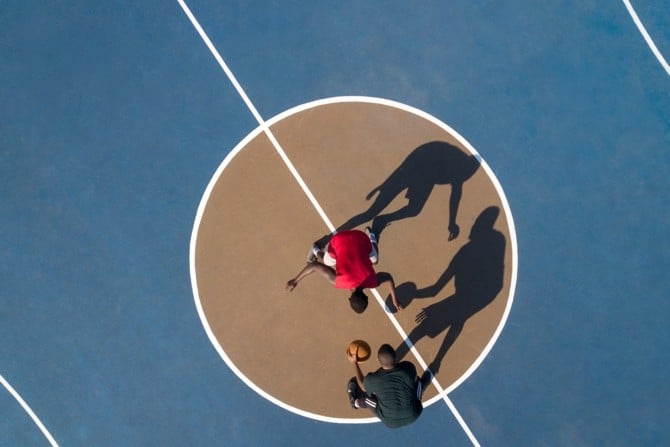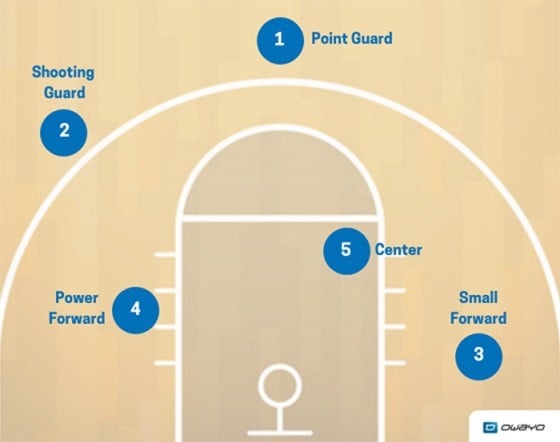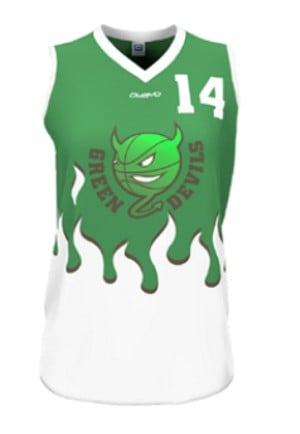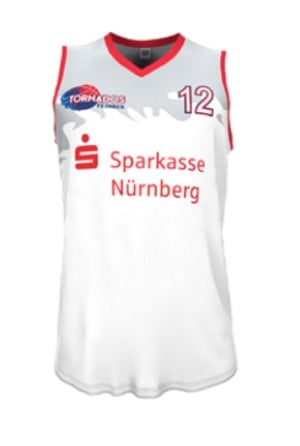Basketball Positions: Responsibilities, Skills and Drills
Everything you need to know about point guards, power forwards and much more.

What does it take to be a point guard and what are they responsible for? In this article, we'll introduce you to all five positions on the court and tell you what drills you need to practice to get good.
At a glance: What are the most important basketball positions?
Five players on the court, seven on the bench - that's the total line-up for a team. Although plenty of players wear two hats at once, players are traditionally assigned to one of the five positions:
- Point Guard
- Shooting Guard
- Small Forward
- Power Forward
- Center
In addition, there are hybrid roles that are basically two or more roles in one:
- Combo Guard
- Swingman
- Point Forward
- Tweener
We'll introduce you to the five standard basketball positions on the court and also four positions that are a combination of standard positions.
The following image shows the positions on the basketball court:

An overview of positions on the court: Tasks, skills and drills
From tall to extremely tall, with a focus on speed or jumping power - each of the five standard basketball positions fulfills different tasks and requires different skills. In this article, we'll explain what the different basketball positions do and introduce you to famous players.
Point Guard
The point guard is usually the captain and acts as the brains of the team. They call the plays and make the plays.
Responsibilities
As the team's playmaker, you are responsible for its success. They signal the plays and initiates them. On defense, they trie to disrupt the opposing team's best ball handler. Together with the shooting guard, the point guard forms the back court, whose job it is to bring the ball out of your own half.
Skills
A point guard is known for their speed and dexterity. They must be an excellent dribbeler. They must be able to keep an overview of the game and react on the fly to its flow.
Physical requirements
The point guard is usually the smallest player on the team. In the NBA, men usually measure between 6'3'' and 6'7'' feet tall.
Well-known players
The most famous point guards in NBA basketball history include:
- Magic Johnson (1979–1991, 1996)
- Stephen Curry (2009–today)
- John Stockton (1984–2003)
- Oscar Robertson (1960–1974)
- Isiah Thomas (1981–1994)
Fun Fact: Magic Johnson was named the best point guard of all time by US sports channel ESPN in 2007. At 6'8'' meters, Johnson is a truly exceptional talent among point guards, especially when it comes to his height.
The most famous point guards in WNBA basketball history include:
- Cynthia Cooper (1992-2000, 2003)
- Cappie Pondexter (2006–2018)
- Becky Hammon (2004-2014)
- Courtney Vandersloot (2011-today)
- Teresa Edwards (1987–2004)
Point Guard training
Dribbling, passes, shooting - a good point guard needs it all.
Coach Damin Altizer from DeepGame introduces you to a complete point guard workout:
Shooting Guard
The shooting guard is also known as the second guard, or off guard. Together with the point guard, these basketball positions form the backcourt.
Responsibilities
The shooting guard's tasks include dribbling and shooting. They must also be able to take on the tasks of the point guard, but play more offensively.
Fun Fact: Until the 1940s, passing was the shooting guard's main focus. Only after the advancement of the modern shooting technique, called the jump shot, the shooting guard's focuse changed to shooting.
Skills
Shooting guards must be particularly agile and quick. It is also important that they can shoot accurately from distance and make three-point shots.
Physical requirements
The shooting guard is usually taller and heavier than the point guard, but is one of the smallest players on the court. In the NBA, most shooting guards are between 6'1" and 6'6" feet tall.
Fun Fact: Until the 1980s, shooting guards were only slightly taller than point guards. This changed with players like Michael Jordan, who started a trend towards wing players up to 6'5" feet tall.
Well-known players
The most famous shooting guards in the NBA include:
- Michael Jordan (1984–2003)
- Kobe Bryant (1996–2016)
- James Harden (2009–today)
- Dwayne Wade (2003–2019)
- Jerry West (1960–1974)
The most famous shooting guards in the WNBA include:
- Diana Taurasi (2005-today)
- Chelsea Gray (2015–today)
- Seimone Augustus (2006–2020)
Training for the shooting guard
The training plan for shooting guards should focus on ball handling and shooting drills with a focus on three-point shots. Coach Collin Castellaw from ShotMechanics presents three shooting drills for shooting guards:
Hybrid position: Combo Guard
Shooting guard meets point guard - this combination gives rise to the basketball position of combo guard. The combination is an unofficial term for players who can play both the basketball position of point guard and shooting guard. The combo guard is divided into three types:
1. shooting guards, who are good passers and can direct a game's flow. This means they can also play at the point guard position.
2. point guards who can also play as shooting guards. They are able to lead the game, but also shoot baskets themselves. They are usually slightly taller than the classic point guards and are good at shooting from distance.
3. shooting guards, who are under 6'9'' tall and therefore as tall as an average point guard. They play more aggressively than a point guard, but cannot completely fill the shooting guard position due to their small stature.
Small Forward
The small forward is considered the all-rounder of the team. Together with the power forward and the center, they form the front court.
Responsibilities
The small forward plays both offensively and defensively. They must be able to hit the basket from mid-range and from the three-point line. On defense, one of their tasks is to prevent the opponent's three-point shot.
Skills
A small forward is usually the most athletic player on a team. They must be particularly agile and have very good jumping ability. They also impress with their excellent dribbling ability.
Physical requirements
A small forward is usually strong and particularly athletic. In the NBA, small forwards are usually between 6'8 meters and 6'10 tall.
Famous Players
From Bird to Pippen - these are the most famous small forwards in NBA history:
- LeBron James (2003–today)
- Larry Bird (1979–1993)
- Kevin Durant (2007–today)
- Julius Erving (1971–1987)
- Scottie Pippen (1987–2004)
Fun Fact: Larry Bird played his entire active basketball career for the Boston Celtics. He wore the number 33 on his jersey. The legendary number has not been reissued by the Celtics to this day.
These are famous small forwards in WNBA history:
- Maya Moore (2011–2018)
- Elene Delle Donne (2013–today)
- Nneka Ogwumike (2012–today)
Training for the small forward
A small forward should primarily train their stamina and strength. In addition, draining shots is always a priority.
Coach Alex from THINCPRO Basketball presents five moves to memorise for all small forwards:
Hybrid position: The Swingman
A swingman, also known as a guard forward, plays two positions at once: shooting guard and small forward. Swingmen are usually between 6'4'' and 6'6'' tall.
Power Forward
The power forward is a team's powerful ace. They are a mix of a small forward and center who play close to the basket.
Tasks and Responsibilities
The power forward's tasks include grabbing rebounds, setting offensive screens and blocking shots. For some years now, the poward forward is proving more integral for a team's success. In a pinch, they are also expected to both shoot three and also spend time in the opponent's paint.
Skills
The power forward requires strength to control their paint under the basket. At the same time, they are required to be accurate shooters.
Physical requirements
Power forwards are particularly strong and are usually the second tallest player on a team. In the NBA, they are usually between 6'7'' and 6'10'' tall.
Famous players
Basketball without Nowitzki and Garnett - hardly imaginable. These players are among the most recognised power forwards in NBA history:
- Dirk Nowitzki (1998-2019)
- Tim Duncan (1997-2016)
- Kevin Garnett (1995-2016)
- Karl Malone (1985-2003)
- Charles Barkley (1984-2000)
Fun Fact: Charles Barkley was nicknamed "The Round Mound of Rebound", which was an allusion to his stature. At 6'4'', he was actually too short and at the same time too stocky for a power forward.
These players are among the most famous power forwards in the WNBA:
- Candace Parker (2009-2024)
- Tim Duncan (2016-today)
- Chiney Ogwumike (2014-2019, 2021-today)
Training for the power forward
As a power forward, you should primarily train defensive body play and scoring from distance and at the basket. The following video from 1x1Sport shows you three different drills to help you score baskets in the paint:
Hybrid Position: Point Forward
Point forwards play like a forward, while having the skill set of a point guard. They are taller than a point guard, yet have comparable ball handling skills to a point guard.
Center
The center, also known as the inside player, five-man or "big man", plays in the paint under the basket and is the largest player on court team.
Responsibilities
The center snatches the rebounds, asserts themself on the court and plays with their back to the basket. Centers play both offense and defense.
Skills
In addition to their size and strength, a center should be quick and agile. It's also important that they are a reliable shooter.
Physical requirements
Centers are the tallest and strongest players on the court. In the NBA, they're usually no shorter than 6'9''.
Famous Players
Here are the most famous centers in the NBA:
- Shaquille O’Neal (1992-2011)
- Kareem Abdul-Jabbar (1969-1989)
- Bill Russell (1956-1969)
- Wilt Chamberlain (1959-1973)
- Hakeem Olajuwon (1984-2002)
Fun Fact: Although Kareem Abdul-Jabbar ended his active playing career in 1989, he still holds the second place for the most points in NBA history with 38,387.
Here are the most famous centers in the WNBA:
- Sylvia Fowles (2008-today)
- Brittney Griner (2013-today)
- Tina Charles (2010-today)
Drills for the center
Centers place emphasis on training their jumping power and speed. It's is also paramount they practise playing with their back to the basket and master the lay up.
The following video gives you 5 drills you can practice to become a better center:
Hybrid Position: Tweener
Tweener is an unofficial term for a jack of all trades. They have different physical and playing abilities, but do not fit exactly into one position in basketball, and are therefore used flexibly.
Whether it's Kareem Abdul-Jabbar's Lakers jersey with the number 33 or Michael Jordan's number 23 with the Bulls, which by the way was auctioned off for 320,000 dollars in 2020 - it pays to have the right gear for the court. In the owayo shop you can design your own basketball jerseys. Get inspired by some example designs:

SSV Schrobenhausen
Design: Fire
See in our 3D Designer

Nuremberg Athletic Club e.V.
Design: Acid
See in our 3D Designer
If you want to read more basketball articles, we recommend the following topics:
Image Credits: Cover image: Hello Africa/gettyimages, Image 2: owayo